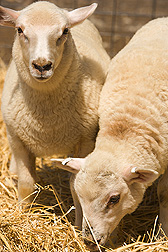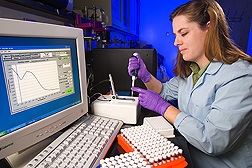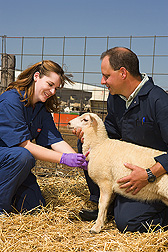Can Genetic Research Scuttle Scrapie?
|
|
Contagious, incurable, and fatal, scrapie is a chief disease priority for the sheep industry. It affects international trade and domestic markets and costs U.S. producers an estimated $20 million every year.
Now Agricultural Research Service (ARS) researchers in Clay Center, Nebraska, have developed more accurate genetic tests for the disease. They believe this achievement will promote scrapie’s eventual eradication.
Like chronic wasting disease in elk or mad cow disease in cattle, scrapie is a transmissible spongiform encephalopathy (TSE). Its name reflects the disease’s most distinctive symptom: an uncontrollable itching sensation that causes afflicted sheep to compulsively scrape their bodies against nearby objects, often tearing out their fleece in the process.
Other symptoms include hypersensitivity to noise, weight loss, convulsive collapse, weakness, and altered gait. Most sheep die 1 to 6 months after symptoms appear, though they may be infected for years without showing any signs.
Some sheep are more susceptible than others. Genetic predisposition to the disease is related to variations in amino acid sequences coded within each sheep’s DNA. Selective breeding for resistance could reduce the genetic risk of developing scrapie and may eventually eradicate it.
Much remains to be learned about this devastating disease, but ARS researchers have made great progress. In Pullman, Washington, in 1998, a team led by microbiologist Katherine I. O’Rourke developed the first practical test for diagnosing scrapie in live animals. Before, the only way to confirm the disease had been to examine a dead animal’s brain for spongy pockets. The new test takes samples from a live sheep’s third eyelid, reducing unnecessary slaughter.
|
|
Today ARS is at the forefront of scrapie research again. Drawing from a diverse group of hundreds of U.S. sheep, Michael P. Heaton, a geneticist at the Roman L. Hruska U.S. Meat Animal Research Center (USMARC) at Clay Center, and his colleagues have resequenced the prion gene, identifying new genetic variation.
This achievement has helped save the industry money by improving commercially available genotyping tests and enhancing the national scrapie eradication program run by USDA’s Animal and Plant Health Inspection Service (APHIS).
Mapping new genetic variation in sheep has allowed the scientists to develop methods for sequencing the complete sheep prion gene-coding region and genotyping prion “haplotypes,” or sets of linked alleles on a chromosome.
They have also identified and stored DNA from sheep representing 15 combinations of the most common prion gene haplotypes. This information is freely available to scientists and testing labs to help with assay design and scrapie eradication.
In short, they’ve amassed a detailed body of knowledge allowing them to test sheep for scrapie susceptibility with great accuracy. With that information, breeders can select less-susceptible sheep and eventually breed scrapie-resistant flocks.
|
|
Better, Faster, Cheaper
“Selection for resistant sheep significantly reduces the overall genetic risk of developing scrapie,” Heaton says.
So how does it work? Connections between genetic variations in prions—proteins that occur naturally in all mammals—and susceptibility to TSE in sheep are well known. In a diseased animal, abnormally folded prion proteins cause the naturally produced prions to fold abnormally as well. As the misfolded proteins amass, they cause neurological problems and eventually death.
Not every sheep that’s exposed to scrapie contracts the disease. This is due, in part, to genetic variation. Three codons (nucleotide trios that specifically code for one amino acid) are thought to influence susceptibility to scrapie. Two codons are used in APHIS’s national eradication program.
Variations in the three codons give rise to five common prion haplotypes in U.S. flocks: ARR, ARQ, ARH, AHQ, and VRQ. Any 2 haplotypes can combine to make 1 of 15 possible diplotypes, which indicate varying degrees of resistance. Identifying which of the haplotypes a sheep has makes it easier to predict its offspring’s susceptibility to scrapie.
“Sheep with a diplotype of ARR/ARR are generally considered the most resistant to classical scrapie. Sheep with a VRQ/VRQ diplotype are most susceptible. Everything else falls somewhere in between,” Heaton says.
Correctly identifying an animal’s diplotype for the prion gene is complicated. Fortunately, Heaton and his colleagues have identified sheep within the USMARC flock that represent each of 15 possible diplotypes for the 5 most common haplotypes. They collected DNA samples from these animals, determined their prion gene coding sequences, and deposited them in a public gene bank to improve genotyping and assay development.
APHIS veterinarian Gary Ross says the USMARC testing program has improved the APHIS scrapie-eradication program.
“The format has enabled us to reduce our total genotyping costs by about 40 percent. We’re doing somewhere between 40,000 and 50,000 tests a year, so that’s a significant cost reduction,” he says. “The cost of testing three codons after using this design was almost 80 percent lower. For the money, this would allow us to test nearly five times more sheep at all three codons than was previously possible. This could potentially accelerate scrapie eradication.”
The USMARC researchers have also examined the codon sites in great detail, enabling them to create more accurate assays, Ross says. “For example, the work they’ve done at codon 171 has been extremely helpful in making it possible to distinguish Q from H. There are some other haplotypes very close by, which made it difficult to do so in the past.”
Essentially, this research is improving the speed, cost, and quality of antiscrapie breeding methods.
“The bottom line is better, faster, cheaper,” says Heaton. “That’s really all it is, but the impact is worth millions.”
More information on the National Accelerated Scrapie Eradication Program, run by USDA-APHIS, is on the Web at www.aphis.usda.gov/vs/nahps/scrapie.—By Laura McGinnis, Agricultural Research Service Information Staff.
This research is part of Animal Health, an ARS National Program (#103) described on the World Wide Web at www.nps.ars.usda.gov.
Michael P. Heaton is with the USDA-ARS Roman L. Hruska U.S. Meat Animal Research Center, Spur 18D, Clay Center, NE 68933; phone (402) 762-4362, fax (402) 762-4375.
"Can Genetic Research Scuttle Scrapie?" was published in the November/December 2006 issue of Agricultural Research magazine.









